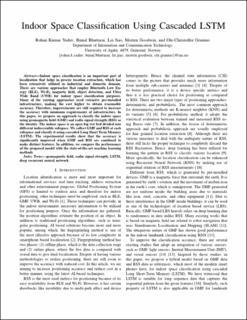| dc.contributor.author | Yadav, Rohan Kumar | |
| dc.contributor.author | Bhattarai, Bimal | |
| dc.contributor.author | Lei, Jiao | |
| dc.contributor.author | Goodwin, Morten | |
| dc.contributor.author | Granmo, Ole-Christoffer | |
| dc.date.accessioned | 2021-03-23T11:27:12Z | |
| dc.date.available | 2021-03-23T11:27:12Z | |
| dc.date.created | 2020-05-08T16:36:13Z | |
| dc.date.issued | 2020 | |
| dc.identifier.citation | Yadav, R. K., Bhattarai, B., Lei, J., Goodwin, M. & Granmo, Ole-C. (2020). Indoor Space Classification Using Cascaded LSTM. IEEE Conference on Industrial Electronics and Applications, 1110-1114. | en_US |
| dc.identifier.isbn | 978-1-7281-5169-4 | |
| dc.identifier.issn | 2158-2297 | |
| dc.identifier.uri | https://hdl.handle.net/11250/2735071 | |
| dc.description | Author's accepted manuscript. | en_US |
| dc.description | © 2020 IEEE. Personal use of this material is permitted. Permission from IEEE must be obtained for all other uses, in any current or future media, including reprinting/republishing this material for advertising or promotional purposes, creating new collective works, for resale or redistribution to servers or lists, or reuse of any copyrighted component of this work in other works. | |
| dc.description.abstract | Indoor space classification is an important part of localization that helps in precise location extraction, which has been extensively utilized in industrial and domestic domain. There are various approaches that employ Bluetooth Low Energy (BLE), Wi-Fi, magnetic field, object detection, and Ultra Wide Band (UWB) for indoor space classification purposes. Many of the existing approaches need extensive pre-installed infrastructure, making the cost higher to obtain reasonable accuracy. Therefore, improvements are still required to increase the accuracy with minimum requirements of infrastructure. In this paper, we propose an approach to classify the indoor space using geomagnetic field (GMF) and radio signal strength (RSS) as the identity. The indoor space is an open big test bed divided into different indiscernible subspace. We collect GMF and RSS at each subspace and classify it using cascaded Long Short Term Memory (LSTM). The experimental results show that the accuracy is significantly improved when GMF and RSS are combined to make distinct features. In addition, we compare the performance of the proposed model with the state-of-the-art machine learning methods. | en_US |
| dc.language.iso | eng | en_US |
| dc.publisher | IEEE | en_US |
| dc.title | Indoor Space Classification Using Cascaded LSTM | en_US |
| dc.type | Journal article | en_US |
| dc.type | Peer reviewed | en_US |
| dc.description.version | acceptedVersion | en_US |
| dc.rights.holder | © 2020 IEEE | en_US |
| dc.subject.nsi | VDP::Teknologi: 500::Informasjons- og kommunikasjonsteknologi: 550 | en_US |
| dc.source.pagenumber | 1110-1114 | en_US |
| dc.source.journal | IEEE Conference on Industrial Electronics and Applications | en_US |
| dc.identifier.doi | https://doi.org/10.1109/ICIEA48937.2020.9248347 | |
| dc.identifier.cristin | 1810019 | |
| dc.relation.project | Universitetet i Agder: CAIR | en_US |
| cristin.qualitycode | 1 | |
